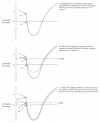Use of continuous negative pressure around the chest increases exercise performance in chronic obstructive pulmonary disease patients: a pilot study
- PMID: 21369549
- PMCID: PMC3071003
- DOI: 10.1155/2011/106132
Use of continuous negative pressure around the chest increases exercise performance in chronic obstructive pulmonary disease patients: a pilot study
Abstract
Background: Patients with severe chronic obstructive pulmonary disease (COPD) often have intrinsic positive end-expiratory pressure. Continuous positive airway pressure has been shown to decrease the inspiratory work of breathing and increases exercise capacity in these patients.
Objective: To determine whether continuous negative pressure (CNP) around the chest is able to bring the positive end-expiratory pressure closer to atmospheric pressure, thereby reducing the threshold load and increasing exercise capability.
Methods: A pilot study was undertaken with eight COPD patients who had been hospitalized for exacerbation and were close to discharge. For CNP, a shell (around the thorax from under the axillae to the mid abdomen) and wrap were used. Each of the eight patients was assessed with a 6 min walk test in three modes (in randomized order) with 30 min of rest in between: a control walk with no shell or wrap; a sham CNP in which the applied CNP was negligible; and CNP, with pressure chosen by the patient that provided maximal relief of dyspnea at rest.
Results: At the end of each of the 6 min walk tests, there was no difference in heart rate, oxygen saturation or level of dyspnea among the three test modes. Respiratory rate was reduced with CNP compared with sham. The patients walked furthest with CNP compared with control (mean ± SD) (313 ± 66.2 m versus 257 ± 65.2 m; P<0.01) and compared with sham.
Conclusions: In the present pilot study, COPD patients improved their exercise performance with CNP.
HISTORIQUE :: Les patients atteints de maladie pulmonaire obstructive chronique (MPOC) ont souvent une pression positive intrinsèque en fin d’expiration. Il est démontré que la pression positive continue réduit le travail inspiratoire et accroît la capacité à l’exercice chez ces patients.
OBJECTIF :: Déterminer si la pression négative continue (PNC) autour du thorax peut rapprocher la pression positive en fin d’expiration de la pression atmosphérique, réduisant ainsi la charge seuil et accroissant la capacité à l’exercice.
MÉTHODOLOGIE :: Les chercheurs ont entrepris une étude pilote auprès de huit patients atteints de MPOC hospitalisés en raison d’une exacerbation et qui devaient bientôt obtenir leur congé. Pour susciter la PNC, ils utilisaient une coquille (autour du thorax, entre les aisselles et le milieu de l’abdomen) et des bandages. Chacun des huit patients était évalué dans le cadre d’une épreuve de marche de six minutes reprise de trois façons (dans un ordre aléatoire) séparées par une période de repos de 30 minutes : une marche témoin sans coquille ni bandage, une PNC placebo au cours de laquelle la PNC appliquée était négligeable et une PNC dont la pression était sélectionnée par le patient afin d’assurer un soulagement maximal de la dyspnée au repos.
RÉSULTATS :: À la fin de chaque épreuve de marche de six minutes, on ne remarquait pas de différence de fréquence cardiaque, de taux de saturation en oxygène ou de dyspnée dans les trois modes de l’épreuve. La fréquence respiratoire était moins élevée avec la PNC qu’avec un dispositif placebo. Les patients parcouraient une plus grande distance avec la PNC que les sujets témoins (moyenne±ÉT) (313±66,2 m par rapport à 257±65,2 m; P<0.01) et que ceux qui utilisaient un dispositif placebo.
CONCLUSIONS :: Dans la présente étude pilote, les patients atteints de MPOC ont amélioré leur rendement à l’exercice grâce à la PNC.
Figures


References
-
- Schuessler TF, Gottfried SB, Bates JH. A model of the spontaneously breathing patient: Applications to intrinsic PEEP and work of breathing. J Appl Physiol. 1997;82:1694–703. - PubMed
-
- Haluszka J, Chartrand DA, Grassino AE, et al. Intrinsic PEEP and arterial PCO2 in stable patients with chronic obstructive pulmonary disease. Am Rev Respir Dis. 1990;141:1194–7. - PubMed
-
- Aldrich TK, Hendler JM, Vizioli LD, et al. Intrinsic positive end expiratory pressure in ambulatory patients with airways obstruction. Am Rev Respir Dis. 1993;147:845–9. - PubMed
-
- El Khawand CH, Vanpee D, Rousseau L, et al. Breathing frequency and use of expiratory muscles do influence the dynamic positive end-expiratory pressure. Respir Med. 2003;97:388–92. - PubMed
-
- Thorevska NY, Manthous CA. Determinants of dynamic hyperinflation in a bench model. Respir Care. 2004;49:1326–34. - PubMed
Publication types
MeSH terms
LinkOut - more resources
Full Text Sources
Medical

